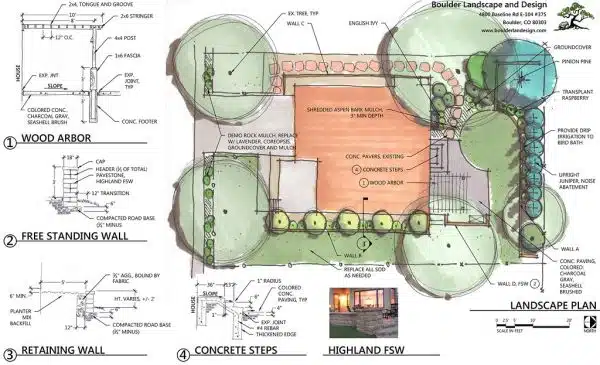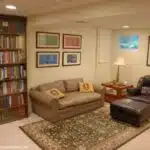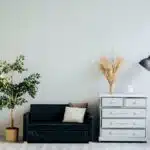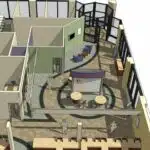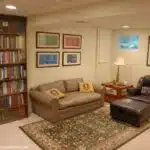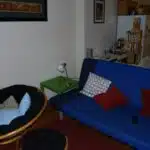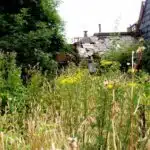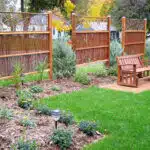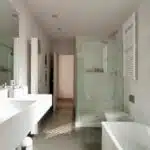Landscape plans can be daunting for beginning DIYers, but with the right guidance and tools, anyone can create a beautiful outdoor space. As a landscape design consultant, I have seen firsthand the transformative power of a well-designed landscape. Whether you are looking to increase your home’s curb appeal or create an inviting backyard oasis, drawing up a landscape plan is the first step in achieving your vision.
Creating a landscape plan requires careful consideration of various factors, such as site analysis, budget constraints, and personal preferences. It is essential to understand the principles of design and how they apply to outdoor spaces. In this article, we will provide helpful tips and tools for beginning DIYers on how to draw landscape plans that meet their needs and enhance their homes’ beauty. With our guidance, you will be able to take your first steps towards creating a stunning outdoor space that serves both functional and aesthetic purposes.
Understanding Site Analysis
Site analysis is an essential aspect of landscape design. Before beginning any project, it’s crucial to understand the terrain and climate of the site. The topography of the land will influence the layout of the design, as well as the selection of plants and materials. For instance, if the site has steep slopes, then a terraced garden may be necessary to prevent erosion and provide stability.
Additionally, understanding the climate is vital for selecting appropriate plant species that can thrive in specific conditions. Different regions have varying temperature ranges, rainfall patterns, and soil types that can impact plant growth. Therefore, it’s crucial to research these factors before choosing which plants to include in your design.
Overall, conducting a thorough site analysis will set the foundation for your landscape plan and ensure its success. By understanding the terrain and climate of your site, you can create a functional and aesthetically pleasing outdoor space that meets your needs while also being sustainable. In the next section, we’ll discuss how to consider budget constraints when developing your plan.
Considering Budget Constraints
As a landscape design consultant, I understand that budget constraints can be a major factor for many DIYers. However, this should not deter you from creating a beautiful outdoor space. There are many budget-friendly plant options available that can create an inviting landscape without breaking the bank. Some popular options include succulents, ornamental grasses, and native plants.
When it comes to DIY landscape installation tips, there are several ways to save money while still achieving professional results. One way is to start small and focus on one area at a time. This will allow you to spread out the cost over time and avoid overspending on unnecessary materials. Another tip is to use recycled or repurposed materials such as old bricks or stones for garden edging or pathways.
Overall, creating a stunning landscape on a budget requires some creativity and strategic planning. By incorporating budget-friendly plant options and utilizing DIY installation tips, you can achieve your desired look without emptying your wallet. In the next section, we will discuss how identifying personal preferences can help guide your landscape design decisions and further enhance your outdoor space.
Identifying Personal Preferences
After considering budget constraints, the next step is to identify personal preferences. This involves determining favorite colors and preferred styles. These preferences will help guide the design process and ensure that the final product is tailored to meet individual needs.
When it comes to color, it is important to consider personal taste as well as the surrounding environment. For example, if the landscape is surrounded by lush greenery, a pop of bright color may be just what is needed to create a stunning focal point. Alternatively, if the surrounding architecture features muted tones, subtle accents of pastel colors may be more appropriate.
Style preference is also crucial in creating a cohesive outdoor space. Some individuals may prefer a minimalist design with clean lines and simple materials while others may opt for a more traditional look with ornate details and natural materials. Determining these preferences early on will help ensure that all design choices are consistent with personal taste.
- Incorporating elements of nature such as water features and plants can create a calming and relaxing atmosphere.
- Playing with different textures can add depth and interest to any landscape design.
- Lighting can transform an outdoor space from day to night, extending its functionality.
- Incorporating sustainable materials like reclaimed wood or recycled plastic can reduce environmental impact while still achieving desired aesthetics.
With personal preferences in mind, applying principles of design to outdoor spaces becomes much easier. By carefully selecting colors, materials, and textures that align with individual style preferences, landscapes can become personalized sanctuaries that promote relaxation and enjoyment of nature.
Applying Principles Of Design To Outdoor Spaces
When it comes to designing outdoor spaces, applying principles of design is crucial. The principles of design are the guidelines that designers use to create a visually appealing and functional space. By using these principles, you can create a cohesive and beautiful landscape plan that meets your needs and preferences.
Designing for sustainability should be a top priority when creating your landscape plan. This means choosing materials that are environmentally friendly and durable, such as recycled or locally sourced materials. You can also incorporate elements like rain gardens or permeable paving to help manage stormwater runoff. Maximizing outdoor living space is another important consideration. By creating different zones for relaxation, entertainment, and dining, you can make the most of your outdoor space and enjoy it year-round.
Implementing the principles of design and focusing on sustainability and maximizing outdoor living space will help you create a landscape plan that meets your needs while also being visually appealing and functional. In the next section, we’ll discuss choosing the right plants for your landscape to further enhance its beauty and functionality.
Choosing The Right Plants For Your Landscape
Now that you have applied the principles of design to your outdoor space, it’s time to choose the right plants for your landscape. Plant placement is crucial in creating a visually appealing and functional garden. It’s important to consider the growth habits of each plant and how they’ll interact with one another.
Before selecting your plants, it’s essential to conduct a soil analysis. Soil testing will determine the pH level, nutrient content, and texture of your soil. This information will help you select plants that are best suited for your specific soil type and ensure that they thrive in their new home. You can purchase a DIY soil test kit or send a sample to a local lab for analysis.
By considering plant placement and conducting a thorough soil analysis, you’ll be able to create a beautiful and sustainable landscape that will flourish for years to come. In our next section, we’ll discuss how to create a focal point in your outdoor space. A focal point draws the eye and adds interest to any garden or landscape design. Whether it’s an ornamental tree or water feature, we’ll explore various options for creating a stunning centerpiece in your outdoor oasis.
Creating A Focal Point
- When creating a landscape plan, choosing a focal point is an important consideration.
- There are many elements that can be used to create a focal point, including structures, trees, plants, or design elements.
- Enhancing a focal point can be done through using strategic placement, color, texture, or other design elements.
- When creating a landscape plan, it is important to consider the size, style, and purpose of the focal point to ensure it best suits the space.
Choosing A Focal Point
Creating a focal point is essential in designing a landscape plan that will captivate the viewer’s attention. The focal point should be carefully chosen to draw the eye towards it and add character to the overall design. Incorporating water features such as fountains, ponds, or streams can create a sense of tranquility while adding visual interest to the space. A well-designed water feature can serve as an excellent focal point, bringing life and energy into your outdoor area.
Sculptures can also be used to create a focal point that complements the surrounding landscape design. Sculptures come in different sizes, shapes, and materials, making it easy to find one that suits your style and preference. When selecting a sculpture for your garden, consider its placement and ensure it blends with your garden’s theme and surrounding plants. A strategically placed sculpture can serve as an attention-grabbing center-piece that adds aesthetic value to your garden.
In conclusion, choosing a focal point is an essential step in creating a captivating landscape plan. Incorporating water features or sculptures are excellent ways of adding visual interest while creating a sense of harmony within the garden space. By working with a professional landscape designer or contractor, you can achieve your desired outcome while ensuring all elements of your design work together seamlessly.
Enhancing A Focal Point
Creating a focal point is an essential aspect of landscape design that adds character and visual interest to outdoor spaces. Once you have identified the focal point, it is essential to enhance it further by adding texture and incorporating lighting. Adding texture involves introducing plants or features that provide depth and contrast to the area surrounding the focal point. Incorporating lighting can highlight your focal point’s unique features, making it stand out even more.
Adding texture is a great way to enhance your chosen focal point as it creates visual interest and provides a sense of contrast. Texture can be introduced through planting different species of plants with varying heights, colors, and leaf shapes around the focal point. Features such as rocks, stepping stones, or decorative mulch can also be added to create visual interest. The use of contrasting textures against the backdrop of your garden will make your focal point stand out and add depth to your overall design.
Incorporating lighting is another excellent way to enhance your chosen focal point. Lighting can be used in various ways, from highlighting specific elements within a water feature or sculpture to illuminating paths leading up to it. It helps draw attention towards the focal point while creating an ambiance that enhances the garden’s overall aesthetic appeal. With proper lighting placement, you can create an inviting atmosphere that draws people towards your garden’s centerpiece.
Incorporating Hardscaping Elements
Designing walkways is an essential aspect of hardscaping in landscape design. Walkways serve as the primary means of circulation around the property, guiding visitors to different areas. When designing walkways, it’s crucial to consider their functionality and aesthetic appeal. Choosing a material that complements the surrounding landscape is vital in achieving a cohesive look. The width of the walkway should be sufficient for people to move comfortably without feeling cramped.
Adding water features can also enhance the overall look and feel of your landscape. Water features may include fountains, waterfalls, ponds, or streams. The sound of running water can create a relaxing environment that invites you to spend more time outdoors. When designing water features, it’s important to consider their scale and proportion with respect to other elements on your property. A large water feature may overwhelm a small space, while a small one may not have much impact on a larger area.
Incorporating hardscaping elements such as walkways and water features can transform your landscape into an oasis of tranquility. A professional landscape designer can help you choose materials and design elements that complement your existing landscaping while adding functionality and beauty to your outdoor space. Understanding the importance of scale and proportion when incorporating hardscaping elements will ensure that your investment enhances rather than detracts from the overall aesthetic appeal of your property.
Understanding The Importance Of Scale And Proportion
Hardscaping elements are an essential part of any landscape design, and incorporating them into your plan can add value to your property. However, it is important to remember that hardscaping elements should be chosen based on their scale and proportion in relation to the overall design. For example, a small patio with oversized furniture will look out of place in a large backyard.
The importance of scale and proportion cannot be overstated when it comes to creating a visually appealing landscape plan. Choosing the right elements is crucial in achieving balance and harmony between different components of your design. A well-designed landscape will have a natural flow that draws the viewer’s eye from one area to another, without any jarring interruptions.
Creating visual interest is another benefit of utilizing proper scale and proportion in your landscape design. By incorporating different textures, shapes, and sizes into your plan, you can create depth and dimension that adds depth to your outdoor space. The use of contrasting colors can also draw attention to certain areas or features within your design. Ultimately, by taking the time to carefully consider scale and proportion when developing your landscaping plan, you’ll create a beautiful outdoor space that both you and others will enjoy for years to come.
Utilizing Color Theory In Your Landscape Design
Color Theory is an essential aspect of landscape design as it can transform a dull space into a vibrant and lively one. Color combinations play a crucial role in enhancing the visual appeal of your outdoor space. It is important to understand the fundamental principles of color theory, such as primary colors, secondary colors, and tertiary colors.
Color psychology is another critical factor to consider when designing your landscape with color. Different colors can evoke various emotions and moods in people. For instance, warm tones such as red and orange tend to stimulate energy levels while cool tones like blue and green create a calming effect. Understanding color psychology can help you choose the right color palette that suits your preferences and aligns with the intended mood for your outdoor space.
When creating color schemes for your landscape design, it’s essential to keep in mind that less is more. Avoid using too many different colors as this can cause confusion and chaos in your overall design. Opt for two or three colors that complement each other well and work towards achieving balance by varying their intensities throughout the space.
Incorporating color theory principles into your landscape design can have a significant impact on enhancing curb appeal. By thoughtfully selecting colors that complement each other well, you can create an inviting outdoor space that draws attention from passersby. In the next section, we will discuss some additional tips on how to enhance curb appeal through landscaping techniques.
Enhancing Curb Appeal
Imagine walking down a street where every house looks the same. The only way to differentiate one from another is by the color of their front doors. Now, imagine walking down that same street, but this time each house has its unique charm and appeal. One has beautiful flowers spilling out of window boxes, while another has a well-manicured lawn with strategically placed trees and shrubs. Which street would you rather live on? Enhancing your curb appeal can make all the difference in creating an inviting and welcoming atmosphere for your home.
Incorporating art into your landscape design is a great way to add personality and interest to your yard. Consider adding a garden sculpture or installing a water feature as a focal point for your front yard. These elements not only add visual interest but also create ambiance and can even increase the value of your property.
Choosing lighting is also essential in enhancing curb appeal. Outdoor lighting can highlight architectural features, such as columns or arches, or illuminate pathways leading up to your home’s entrance. Additionally, it adds an extra layer of security by deterring potential intruders. Just ensure that any lighting fixtures blend well with your overall landscape design and are appropriately placed to avoid glare or harsh shadows.
Now that you have some ideas for enhancing your curb appeal let’s move on to creating an inviting backyard oasis!
Creating An Inviting Backyard Oasis
Once you have a solid landscape plan in place, it’s time to start thinking about how you want to use your outdoor space. One of the best ways to create an inviting backyard oasis is by investing in some high-quality outdoor furniture. Whether you prefer cozy lounge chairs or a spacious dining set, there are plenty of options out there that can help you transform your backyard into an entertainment hub for family and friends.
Another important consideration when designing your backyard oasis is lighting. Depending on your needs and preferences, you may want to install overhead lights or invest in some stylish lanterns or string lights. Not only can the right lighting options help improve visibility and safety during nighttime hours, but they can also add a warm and welcoming ambiance to your outdoor space.
When selecting backyard furniture and lighting options, it’s important to keep your budget and style preferences in mind. There are countless products on the market today, so take the time to research different brands and read customer reviews before making any purchasing decisions.
As you embark on creating your own backyard oasis, remember that there are many online tools available that can help streamline the planning process. From virtual design programs to online tutorials and inspiration galleries, these resources can be invaluable when it comes to bringing your vision to life. With the right tools at your disposal, you’ll be well on your way to enjoying a beautiful and functional outdoor space that truly reflects your personal style and needs.
Using Online Tools For Landscape Planning
Online resources have made landscape planning more accessible than ever before. With the abundance of DIY tutorials and online tools, even those new to landscaping can create plans that are both functional and aesthetically pleasing. These resources allow for greater creativity and experimentation, as well as the ability to easily make changes and adjustments to plans.
One of the best things about using online tools for landscape planning is that they often provide 3D renderings of your design. This allows you to see what your plan will look like in real life, giving you a better sense of how it will fit into your existing space. Additionally, many tools also provide plant and material lists, making it easier to budget for your project and ensuring that you choose plants that are appropriate for your climate.
While online resources are incredibly helpful, it’s important to remember that they should be used as a starting point rather than a definitive guide. Every yard is different, with its own unique set of challenges and opportunities. As such, it’s important to use these tools in conjunction with other resources, such as books on landscaping or consultations with professionals.
Incorporating online resources into your landscape planning process can be incredibly rewarding. By taking advantage of these tools, you’ll be able to create a plan that is tailored specifically to your needs while also staying within your budget. Next step: seeking inspiration from other landscapes.
Seeking Inspiration From Other Landscapes
Visiting public gardens can be an excellent source of inspiration for landscape design, as they provide an opportunity to observe a variety of plants and colour combinations. Researching online resources can also provide helpful advice and suggestions for specific plants and elements best suited to various climates. Exploring nature reserves is a great way to observe plants in their natural habitats and understand their needs in different environments. Studying climate needs can guide the selection of plants and materials to ensure the landscape design lasts for years to come. Photos of other designs can provide great insight into colour combinations, architectural elements, lighting effects and textures. Asking friends for advice, and consulting experts, can ensure the design incorporates the needs of the environment and the homeowner.
Visiting Public Gardens
The best way to explore design and find inspiration for your landscape plans is by visiting public gardens. These gardens offer a wide range of designs and ideas that you can incorporate into your own backyard. As a landscape design consultant, I recommend taking the time to visit different gardens, walking around and observing the various elements that make up each garden.
When exploring a public garden, take note of the plants used, their arrangement, and how they are combined with other plants to create a harmonious effect. Look at the hardscaping elements such as paths, walls, water features or sculptures. Notice the use of color in flowers, foliage and hardscaping materials. Observe how light affects different parts of the garden during different times of day or seasons.
Visiting public gardens is an excellent way to gain insight into what works well in landscape design. By finding inspiration from these landscapes, you can bring new ideas to your own backyard project. Take photos or make sketches of details that you like so you can reference them later when designing your own landscape plan. With careful observation and attention to detail, you will be able to create a beautiful outdoor space that reflects your personal style and tastes.
Researching Online Resources
After exploring public gardens, it’s time to extend your search for inspiration by researching online resources. The internet is a treasure trove of information on landscape design, with countless websites dedicated to sharing tips and ideas. Online tutorials can provide step-by-step instructions on how to create specific landscape features or designs. DIY forums offer opportunities for interaction with other homeowners who are also interested in landscaping, making it possible to exchange ideas and ask for advice.
When researching online resources, it’s important to exercise caution and verify the credibility of the sources you use. Look for reputable websites that offer expert advice from experienced professionals in the industry. Avoid relying solely on user-generated content since there is no guarantee that the information provided is accurate or reliable.
One advantage of using online resources is that they are accessible at any time, allowing you to gather inspiration whenever you have free time. You can browse through photos, videos or articles showcasing different types of landscapes from around the world. This way, you can expand your knowledge on various design trends and techniques while staying updated with the latest innovations in landscaping. By leveraging online resources effectively, you’ll be able to uncover new ideas that will help bring your dream landscape project to life.
Exploring Nature Reserves
As a landscape design consultant, I highly recommend exploring nature reserves when seeking inspiration for your landscaping project. Exploring trails and observing the natural environment can provide you with valuable insights on how to incorporate natural elements into your design. These reserves offer a diverse range of landscapes, from forests and wetlands to deserts and mountains, providing ample opportunities to explore the different types of plants, trees, and wildlife that thrive in these environments.
Nature reserves are not only great sources of inspiration but also offer numerous benefits for our well-being. Spending time in nature has been proven to reduce stress levels, improve mental health, and boost creativity. By immersing yourself in natural surroundings, you can gain new perspectives on how to integrate organic features into your design while creating a relaxing outdoor space that promotes wellness.
Exploring nature reserves is also an excellent way to learn about sustainable practices in landscaping. Many nature reserves prioritize conservation efforts by using eco-friendly solutions such as rainwater harvesting, composting, and organic pest control methods. By observing these practices firsthand, you can gain insight into how to develop an environmentally conscious landscape that reduces waste and preserves natural resources.
Working With Professionals
After seeking inspiration from other landscapes, it is important to consider collaborating with experts in landscape design. While DIY projects can be fulfilling, some aspects of landscaping require specialized knowledge and skills that only professionals possess. Collaborating with experts can help ensure that your landscape plan meets your expectations and is executed correctly.
Establishing communication with a landscape design professional is crucial in the collaboration process. Be clear about your goals, budget, and timeline for the project. This will help the designer understand your vision and suggest appropriate solutions. It is also important to communicate any concerns or questions you may have during the planning and execution stages of the project.
Working with professionals can provide numerous benefits, including access to specialized equipment, expertise in plant selection and placement, and knowledge of local regulations. However, it is essential to find a reliable designer who understands your needs and has experience working on similar projects. With proper communication and collaboration, you can achieve a beautiful landscape design that exceeds your expectations.
Transitioning into the subsequent section about maintaining your landscape design: As important as it is to establish communication with experts during the planning stage, maintaining your newly designed landscape requires consistent effort as well.
Maintaining Your Landscape Design
Once your landscape design is complete and implemented, the next step is to ensure that it continues to thrive. Proper maintenance is crucial in keeping the space looking its best and maximizing its potential. Here are some tips to help you maintain your landscape design:
Regularly water your plants and lawn: Watering is essential for the growth of plants, and different plants have varying requirements for watering. Ensure that you water your plants deeply but infrequently, allowing the soil to dry out slightly between watering sessions.
Prune regularly: Pruning is a necessary task to keep your landscape healthy and attractive. Regular pruning of shrubs and trees will promote healthy growth, remove dead or diseased branches, and create an aesthetic appeal.
Perform seasonal maintenance: Different seasons require various types of maintenance work on your landscape design. For instance, during fall, you may need to rake leaves, while in winter, you may need to clear snow from walkways and driveways.
Maximizing space in your landscape design can be challenging; however, proper maintenance can make it easier. As a landscape design consultant, I encourage homeowners always to take care of their outdoor spaces by performing routine maintenance tasks such as watering plants deeply but infrequently and pruning regularly. Additionally, performing seasonal maintenance tasks such as raking leaves during fall or clearing snow from walkways during winter will help maintain the beauty of your outdoor space without overwhelming you with too much work.
Remember that maintaining your landscape design takes time and effort; however, it is crucial in ensuring its longevity and continued beauty. By following these tips on regular watering, pruning regularly throughout the year, and performing seasonal maintenance work like raking leaves in fall or clearing snow from walkways during winter months – homeowners can enjoy a beautiful outdoor living area all year round!
Conclusion
To successfully draw landscape plans, it is essential to have a clear understanding of site analysis, budget constraints, personal preferences, and design principles. Begin the planning process by identifying key features of your property and assessing any potential challenges or opportunities presented by the environment. Consider how much money you are willing to spend on your project and prioritize your needs accordingly. Once you have established a budget, think about what elements you would like to include in your landscape design based on your personal tastes.
Next, utilize the principles of design to create an aesthetically pleasing outdoor space that is both functional and visually appealing. Pay attention to factors such as balance, proportion, color, texture, and scale when choosing plants and other landscaping materials. Online tools can be helpful for visualizing your design ideas and experimenting with different layouts before committing to a final plan.
Seek inspiration from other landscapes that you admire and work with professionals if necessary to ensure that your vision is executed correctly. Finally, be prepared to maintain your landscape design over time by regularly pruning plants, weeding garden beds, and addressing any issues that arise. With these tips in mind, anyone can create a beautiful outdoor space that reflects their unique style and meets their practical needs.
Image Credits
- “Girolimon Residence- Landscape Plan” by Jay@MorphoLA (featured)

